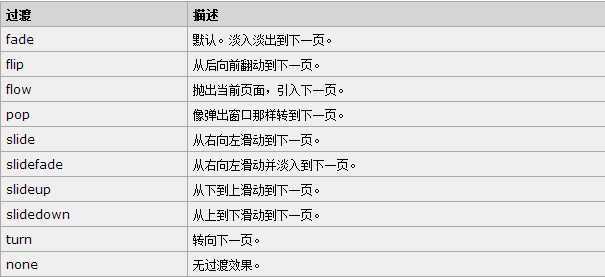jQuery Mobile 过渡效果
时间:2014-05-10 01:11:52
收藏:0
阅读:414
jQuery Mobile 拥有一系列关于如何从一页过渡到下一页的效果。前提是浏览器必须支持 CSS3 3D 转换:
浏览器支持
- Internet Explorer 10 支持 3D 转换(更早的版本不支持)
- Opera 仍然不支持 3D 转换
过渡效果可应用于任意链接或通过使用 data-transition 属性进行的表单提交:
下面的表格展示了可与 data-transition 属性一同使用的可用过渡:

以上所有效果同时支持反向动作,例如,如果您希望页面从左向右滑动,而不是从右向左,请使用值为 "reverse" 的 data-direction 属性。在后退按钮上是默认的。
<!DOCTYPE html> <html> <head> <meta http-equiv="Content-Type" content="text/html; charset=utf-8" /> <title></title> </head> <link rel="stylesheet" href="http://code.jquery.com/mobile/1.3.2/jquery.mobile-1.3.2.min.css"> <script src="http://code.jquery.com/jquery-1.8.3.min.js"></script> <script src="http://code.jquery.com/mobile/1.3.2/jquery.mobile-1.3.2.min.js"></script> </head> <body> <div data-role="page" id="pageone"> <div data-role="header"> <h1>HEADER</h1> </div> <div data-role="content"> <p>点击链接来查看滑动效果</p> <a href="#pagetwo" data-transition="slide">滑动到页面二</a> </div> <div data-role="footer"> <h1>FOOTER</h1> </div> </div> <div data-role="page" id="pagetwo"> <div data-role="header"> <h1>我是一个对话框!</h1> </div> <div data-role="content"> <p>点击链接来查看滑动效果</p> <a href="#pageone" data-transition="slide">滑动到页面一</a><!--加上该属性data-direction="reverse" 可以实现反向滑动--> </div> <div data-role="footer"> <h1>页脚文本</h1> </div> </div> </body> </html>
评论(0)

